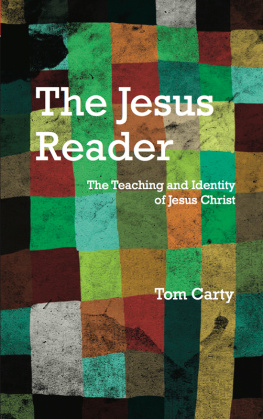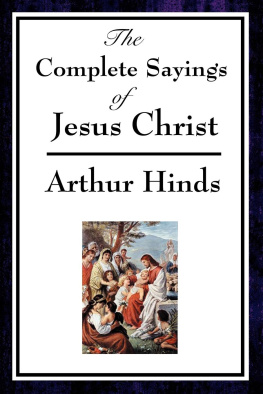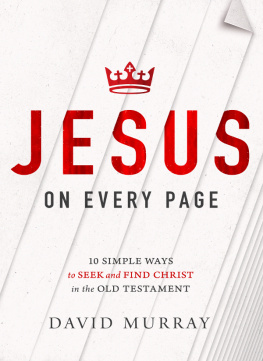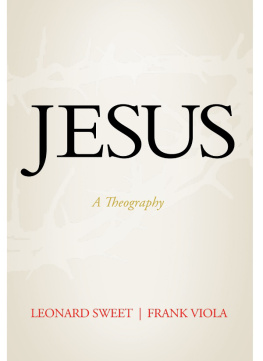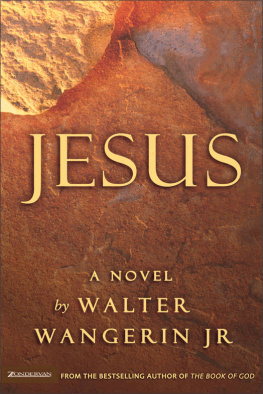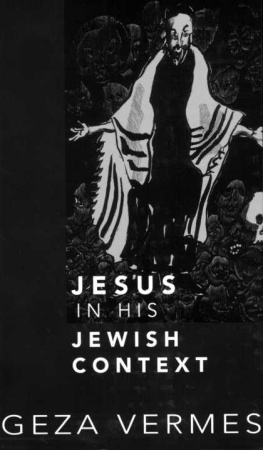THE JESUS READER
To
Thomas William Carty and Anne Kiely,
my parents
Tom Carty
The Jesus Reader
THE TEACHING AND IDENTITY OF JESUS CHRIST

First edition, 2013, published by
The Columba Press
55A Spruce Avenue, Stillorgan Industrial Park,
Blackrock, Co. Dublin
Cover artwork and illustrations by Eve Anna Farrell
Origination by The Columba Press
Printed in Ireland by SPRINT-print
ISBN 978 1 85607 877 1
The scripture quotations contained herein are from the New Revised Standard Version of the Bible, anglicised edition, copyright 1989, 1994 by the Division of Christian Education of the National Council of Churches of Christ in the United States of America, and are used by permission. All rights reserved.
Many thanks to Phil Ibbs who introduced me to Lectio Divina and who leads the St Wulstans meditation group with such insight. Thanks also to the members of the group who over the years have never failed to inspire, especially Mary Walker RIP.
Copyright 2013, Thomas Carty
Introduction
Who do you say I am?
For most people, whatever their beliefs, Jesus Christ is a fascinating and attractive figure. But who was he? This book sets out to answer the question through a selection of scriptural readings concentrating on his identity and teaching.
The most obviously accessible aspect of the gospels is Jesus ethical teaching. Many who have no religious faith readily recognise him as a great and original moral teacher. He can be more demanding than the norms of his (and our) time, for example in his teaching on money (Readings 14.1 and 14.2) or divorce (see Luke 16:18), and his taking into account inner attitude, such as lust for the spouse of another, or anger (see Reading 10.1) rather than simply the external act (adultery or violence). On the other hand, he shows more flexibility and understanding than is usual in convent ional morality, for example when he surprisingly does not condemn the adulterous woman who is dragged before him (Reading 12.2). These examples demonstrate the authority which we are told contemporaries noted. There is also an element of playful rhetorical exaggeration in his teaching meant to catch listeners unawares so they will think afresh about this subject (for example, Reading 14.1).
However, the same authors who bring us that sublime teaching also have definite views on his identity and these too are part of their overall message. To give a true account of Jesus teaching, we have at the same time to do justice to who they thought he was. The book therefore has three specific aims:
- Using their own words, give an idea of how Jesus contemporary and near-contemporary followers expressed his identity.
- Wherever possible, to allow his teaching to speak for itself.
- To enable you to decide what Jesus Christ means to you, and to provide material for further thought.
Against that background, the book has been written with the overall aim of encouraging and enabling the reader to engage directly with scriptural texts. You can read the material in any order. It is presented thematically by chapter, each numbered consecutively, as are the individual readings. There are introduct ory notes on each chapter and detailed introductions to the two parts of the book, on Jesus identity and his ethical teaching respectively.
You can read through or dip into it, but the suggestion is that you at least occasionally read one (or two if you prefer to combine shorter readings on the same topic) of the extracts in a concentrated way, and then spend just 15 to 20 minutes allowing what you have read to take your mind wherever it will. This simple technique of focused, reflective reading recognises that each reader brings something unique to a text. As aids to reflection, you will also find open-ended questions where appropriate, as well as some suggestions for the visualisation of scenes from the gospels. There is a short guide to focused reading in the next section, and, towards the end of the book, a summary of all the books of the Bible featuring in the readings or in the notes on each chapter. In the appendices you will also find notes on reading-based meditation, on using candles and icons as aids to focus in spiritual reading and a comprehensive glossary including a list of names.
The very word reading recognises the role of the reader in giving texts meaning. Each reader brings to the text his or her own unique experience and that is what makes focused reading so exciting. At the same time, especially in the case of books such as the Bible, you have to be aware that they have a history, and in reading extracts from it, you are entering a dialogue across the cent uries. The introductions to Parts One and Two and the notes on each topic and on the individual readings provide you with some background and focus.
In the end, though, this book is about your personal reading of scripture. It is not primarily about Christian doctrine, and it was not written in an attempt to convert readers to any form of Christianity but in the conviction that it is culturally and spiritually important to know something about Jesus Christ, who he was and what he taught, and that the best way of doing that is to read the scriptures in an engaged and informed way. You can then come to your own conclusions about him.
Tom Carty, Easter, 2012
Focused Reading
Keeping an open mind
Try to come to the readings, even (or especially) to very familiar texts, as if for the first time: it is precisely when you think you know a text that you are probably missing something important. If you do not already know the scriptural readings in this book, it does not matter at all, in fact it could even be an advantage. Similarly, you do not need to be a believer to benefit from giving serious attention to the message about Jesus Christ or his ethical teaching. In either case, attentive reading followed by calm thought or meditation will ensure you get the most out of it. Bear in mind that this is about the interaction of the text with your life, experience and feelings, so even a one- or two-sentence extract could easily turn out to be packed with significance for you and provide ample raw material for your fifteen to twenty minutes.
How to go about reading
- Take time to ensure you are physically and mentally relaxed before you begin. Empty your mind and do not pursue any thoughts that arise. This may prove difficult at first, but persevere, because with practice five minutes will normally be enough for you to get into the correct frame of mind, though you may need longer if you are particularly distracted or agitated. You may find an appropriate aid to relaxation and focus helpful, for example, a candle (see appendix two on candle meditation), if it is safe to light one.
- Read slowly and deliberately (reading out loud prevents you from skimming the text). Pause a while before reading it through a second time, then cover it or put it aside until you need to check something or find a word or phrase.
- Now let the reading or readings you have selected speak to you in silence for fifteen to twenty minutes. Give what you have read your full attention but let it approach you rather than the other way around, and be disciplined in focusing fully on what you have read, simply letting other, irrelevant, thoughts and sens ations go without following them. The aim is to go with the passage wherever it takes you. Sometimes you will need to be patient as nothing seems to be happening at first, while at other times a word, phrase or idea will instantly make a connection and you are on your way. And it does not necessarily have to be directly related to the subject of the reading: the text is your starting point, not your goal. If your meditation reaches a natural end, or is getting nowhere at all, you can use the suggested word or phrase in bold letters in the text of each reading instead. There is nothing sacred about 15-20 minutes, if you find that less or more time suits you better, trust your instinct. However, it is probably best to stick to a fixed period of time once you have found what suits you.
Next page
